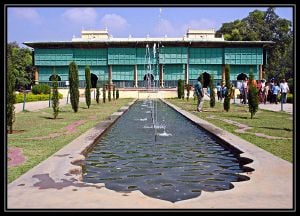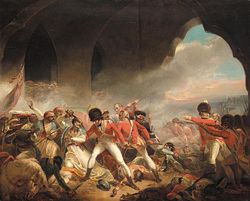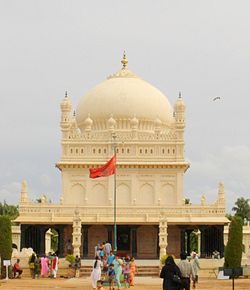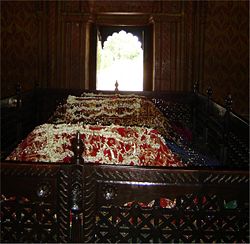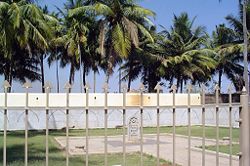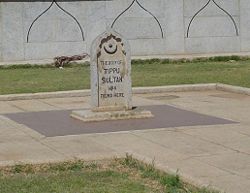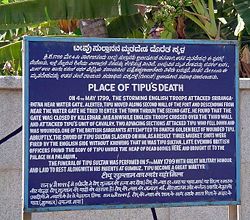| Tippu Sultan | ||
|---|---|---|
| Ruler of Mysore | ||
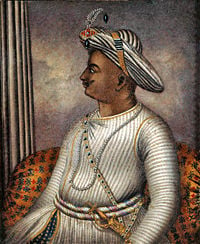
| ||
| Reign | 1782 - 1799 | |
| Born | November 20, 1750 | |
| Devanahalli | ||
| Died | May 4, 1799 | |
| Srirangapattana | ||
| Predecessor | Haider Ali | |
| Father | Haider Ali | |
| Mother | Fakhr-un-nissa | |
Sultan Fateh Ali Tipu, also known as the Tiger of Mysore (November 20, 1750, Devanahalli ‚Äď May 4, 1799, Srirangapattana), was the first son of Haidar Ali by his second wife, Fatima or Fakhr-un-nissa. He was the de facto ruler of the Kingdom of Mysore from the time of his father's death in 1782 until his own demise in 1799. He had a vision and a mission in life. The vision was to make his people enlightened and prosperous; his mission was to liberate his land from the yoke of the colonial power. His short but stormy rule is significant because of his view that the only life worth living was one of freedom, not only political freedom but also social freedom, economic freedom, cultural freedom, and freedom from want, hunger, apathy, ignorance and superstition.
Tipu Sultan was a learned man and an able soldier. He was reputed to be a good poet. He was a devout Muslim, although his Hindu subjects (who were the majority) were staunchly loyal to him. At the request of the French, he built a church, the first in Mysore. In alliance with the French in their struggle with the British both Tippu Sultan and Haidar Ali did not hesitate to use their French trained army against the Maharattas, Sira, Malabar, Coorg and Bednur. He helped his father Haidar Ali defeat the British in the Second Mysore War, and negotiated the Treaty of Mangalore with them. However, he was defeated in the Third Anglo-Mysore War and in the Fourth Anglo-Mysore War by the combined forces of the British East India Company, the Nizam of Hyderabad, the Mahratta Confederacy, and to a lesser extent, Travancore. Tipu Sultan died defending his capital Srirangapattana, on May 4, 1799. He is an iconic but also a controversial figure in post-colonial India. For many, he represents resistance against imperialism. He is remembered as a champion of liberty, of the people's welfare and of inter-community harmony and also as a pioneer of technology. Others challenge his reputation for tolerance and accuse him of anti-Hindu bigotry.[1] To some degree, Tippu's legacy has become a subject of polemics and a tool in the hands of opposing sides in debate about the historical nature of Hindu-Muslim relations in India. He was the only eighteenth-century ruler in India who did not side with the British against other Indians and it was only in alliance with other Indian rulers that the British were able to finally defeat him.
Early life
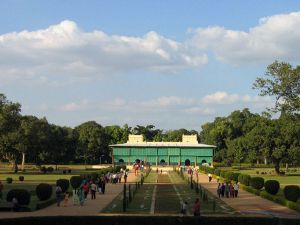
Tipu Sultan was born at Devanahalli, in present-day Bangalore District, some 45 miles east of Bangalore city. The exact date of his birth is not known; various sources claim various dates between 1749 and 1753. According to one widely accepted dating, he was born on Nov 10, 1750 (Friday, 10th Zil-Hijja, 1163 AH). His father, Haidar Ali, was the de-facto ruler of Mysore. His mother, Fakhr-un-nissa (also called Fatima), was a daughter of Shahal Tharique, governor of the fort of Cuddapah.
When his father died in 1782, he succeeded as de facto ruler of Mysore, adopting the title of Padishah (Emperor of Mysore) although he is more commonly referred to as "Sultan of Mysore." Only after his death were the Hindu Wadiyar rulers restored but as clients of the British.
His rule
During his rule, Tipu Sultan laid the foundation for a dam where the famous Krishna Raja Sagara Dam across the river Cauvery was later built. He also completed the project of Lal Bagh started by his father Haidar Ali, and built roads, public buildings, and ports along the Kerala shoreline. His trade extended to countries which included Sri Lanka, Afghanistan, France, Turkey, and Iran. Under his leadership, the Mysore army proved to be a school of military science to Indian princes. The serious blows that Tipu Sultan inflicted on the British in the First and Second Mysore Wars affected their reputation as an invincible power. Dr. APJ Abdul Kalam, the former President of India, in his Tipu Sultan Shaheed Memorial Lecture in Bangalore (November 30, 1991), called Tipu Sultan the innovator of the world’s first war rocket. Two of these rockets, captured by the British at Srirangapatna, are displayed in the Woolwich Museum Artillery in London. Most of Tipu Sultan's campaigns resulted in remarkable successes. He managed to subdue all the petty kingdoms in the south. He defeated the Marathas and the Nizams several times and was also one of the few Indian rulers to have defeated British armies. Until his eventual defeat, Tippu was "demonized by the British as another Siraj ud-Daulah, an unhinged, bloodthirsty despot, and was habitually referred to as "the usurper" who had "supplanted the ancient Hindu constitution" although as thus writer comments, the British had little right to set themselves up as "judges of legitimacy."[2]
A competent administrator, he extended the tax base, linked revenue from specific parcels of land to fund institutions and employed former enemies in his service to gain their trust.[3]
Religious policy
Tipu Sultan was a secular ruler, in whose State there were generally very positive inter-community relations. The very fact that during his entire regime, despite the numerous wars, there was not a single uprising of the people, which shows the popularity of his rule. Such assessment of his character that he was intolerant was more a requirement as a necessary framework for colonial rule. The Indian people had never known any religious war, and Tipu would not think of any distinction of his subjects on the basis of caste, creed or class. He was quite conscious of the fact that when the overwhelming majority of his subjects were Hindus, he could hardly afford to be anything other than secular, humane and liberal. He would well remember the statement of his father, Haider Ali, who had snubbed a Muslim saint for complaining that some Hindus had committed excess on his followers, and that as the head of a Muslim Government, he should redress his grievances, by saying "Who told you that this was a Mussalman Government?" Tipu knew very well that he could not administer the state on principles unacceptable to his subjects.
There are numerous instances depicting the secular character of his rule. Once a faujdar reported to him that a Hindu had married a Muslim lady causing tension in the locality, and wanted to know what action to be taken. Tipu wrote back immediately admonishing the faujdar that it was none of his business to interfere in the personal affairs of the people, and that his duty was merely to safeguard the life and property of the people, and ensure peace.
As a Muslim ruler in a largely Hindu domain, Tipu Sultan never faced any problems in establishing the legitimacy of his rule, and in reconciling his desire to be seen as a devout Islamic ruler with the need to be pragmatic to avoid antagonizing the majority of his subjects. In 1782 C.E. following his father's death he declared himself to be the Padishah or Emperor of Mysore, and struck coinage in his own name without reference to the reigning Mughal Emperor, Shah Alam II. Instead, he obtained a decree of legitimacy from the Ottoman Caliph.[4]
While eminent scholars have denied that, in common with most rulers of his period, Tipu Sultan’s campaigns were often characterized by lesser brutality, as compared with the British who, looted, massacred, raped and pillaged Srirangapatan immediately after its fall. Some historians have said that the extent of force was not exclusively motivated by religion, and it did not amount to a anti-Kafir policy. Brittlebank, Hasan, Chetty, Habib and Saletare, amongst others, argue that stories of Tipu Sultan's religious persecution of Hindus and Christians are largely derived from the work of early British authors such as Kirkpatrick[5] and Wilks,[6] whom they do not consider to be entirely reliable.[7]A. S. Chetty argues that Wilks’ account in particular cannot be trusted,[8] Irfan Habib and Mohibbul Hasan argue that these early British authors had a strong vested interest in presenting Tipu Sultan as a tyrant from whom the British had "liberated" Mysore.[9] Mohibbul Hasan writes "The reasons why Tipu was reviled are not far to seek. Englishmen were prejudiced against him because they regarded him as their most formidable rival and an inveterate enemy, and because, unlike other Indian rulers, he refused to become a tributary of the English Company. Many of the atrocities of which he has been accused were allegedly fabricated either by persons embittered and angry on account of the defeats which they had sustained at his hands, or by the prisoners of war who had suffered punishments which they thought they did not deserve. He was also misrepresented by those who were anxious to justify the wars of aggression which the Company's Government had waged against him. Moreover, his achievements were belittled and his character blackened in order that the people of Mysore might forget him and rally round the Raja, thus helping in the consolidation of the new regime." [10] This assessment is echoed by Brittlebank in her recent work where she writes that Wilks and Kirkpatrick must be used with particular care as both authors had taken part in the wars against Tipu Sultan and were closely connected to the administrations of Lord Cornwallis and Richard Wellesley, 1st Marquess Wellesley.[11]
Mohibbul Hasan, Sheikh Ali and eminent historians cast great doubt on the scale of the deportations and forced conversions in Coorg in particular, and Hasan says that the English versions of what happened were intended to malign Tipu Sultan, and to be used as propaganda against him. He argues that little reliance can be placed in Muslim accounts such as Kirmani’s "Nishan-e Haidari"; in their anxiety to represent the Sultan as a champion of Islam, they had a tendency to exaggerate and distort the facts: Kirmani claims that 70,000 Coorgis were converted, when forty years later the entire population of Coorg was still less than that number. According to Ramchandra Rao "Punganuri" the true number of converts was about 500.[12] The portrayal of Tipu Sultan as a religious bigot is disputed, and some sources suggest that he in fact often embraced religious pluralism. Tipu Sultan's treasurer was Krishna Rao, Shamaiya Iyengar was his Minister of Post and Police, his brother Ranga Iyengar was also an officer and Purnaiya held the very important post of "Mir Asaf." Moolchand and Sujan Rai were his chief agents at the Mughal court, and his chief "Peshkar," Suba Rao, was also a Hindu.[13] There is such evidence as grant deeds, and correspondence between his court and temples, and his having donated jewelry and deeded land grants to several temples, which some claim he was compelled to do in order to make alliances with Hindu rulers. Between 1782 and 1799 Tipu Sultan issued 34 "Sanads" (deeds) of endowment to temples in his domain, while also presenting many of them with gifts of silver and gold plate. The Srikanteswara Temple in Nanjangud still possesses a jeweled cup presented by the Sultan.[14]
In 1791, some Maratha horsemen under Raghunath Rao Patwardhan raided the temple and monastery of Sringeri Shankaracharya, killing and wounding many, and plundering the monastery of all its valuable possessions. The incumbent Shankaracharya petitioned Tippu Sultan for help. A bunch of about 30 letters written in Kannada, which were exchanged between Tippu Sultan's court and the Sringeri Shankaracharya were discovered in 1916 by the Director of Archaeology in Mysore. Tippu Sultan expressed his indignation and grief at the news of the raid, and wrote:
"People who have sinned against such a holy place are sure to suffer the consequences of their misdeeds at no distant date in this Kali age in accordance with the verse: "Hasadbhih kriyate karma ruladbhir-anubhuyate" (People do [evil] deeds smilingly but suffer the consequences crying)."[15]
He immediately ordered his "Asaf" of Bednur to supply the Swami with 200 "rahatis" (fanams) in cash and other gifts and articles. Tippu Sultan's interest in the Sringeri temple continued for many years, and he was still writing to the Swami in the 1790s C.E.[16] In light of this and other events, B.A. Saletare has described Tippu Sultan as a defender of the Hindu Dharma, who also patronized other temples including one at Melkote, for which he issued a Kannada decree that the Shrivaishnava invocatory verses there should be recited in the traditional form. The temple at Melkote still has gold and silver vessels with inscriptions, indicating that they were presented by the Sultan. Tippu Sultan also presented four silver cups to the Lakshmikanta Temple at Kalale.[17] Tippu Sultan does seem to have repossessed unauthorized grants of land made to Brahmins and temples, but those which had proper "sanads" were not. It was a normal practice for any ruler, Muslim or Hindu, to do on his accession or on the conquest of new territory.
The Srikanteswara temple at Nanjungud was presented with a jeweled cup and some precious stones. To another temple, Nanjundeswara, in the same town of Nanjungud, he gave a greenish linga to Ranganatha temple at Srirangapatana he gifted seven silver cups and a silver camphor burner. This temple was hardly a stone's throw from his palace from where he would listen with equal respect the ringing of temple bells, and the Muezzin's call from the mosque.
Yaar Mohammad‚ÄĒTippu's General
Yaar Mohammad, the right hand of Sultan Tipu, was born in eighteenth century, in a Muslim Rajput family to Shah Mohammad, a Sufi saint. He joined the Army of Mysore and soon became one of the favorite generals of Tippu Sultan. Seeing his patriotic and dauntless behavior, Tippu Sultan made him his Commander-in-Chief. He fought dauntlessly in the Battle of Seringapatam (1799), but after Tippu's death, and later the fall of Mysore, he had to run away. However, he managed to evade capture by the British. After the fall of Mysore, he was declared one of the most wanted Mysore officers. They tried their best to capture him, dead or alive, but couldn’t succeed. General Yaar Mohammad's family members and relatives were killed by the British, however, he, along with his father Shah Noor Mohammad and son Ilahi Baksh, escaped. They spent the rest of their lives as fugitives. General Yaar Mohammad died in early nineteenth century. His descendants still live in Punjab today.
Description
Alexander Beatson, considered to be a propagandist Author who, published a volume entitled "View of the Origin and Conduct of the War with the late Tippoo Sultaun" on the Fourth Mysore War, described Tippu Sultan as follows: "His stature was about five feet eight inches; he had a short neck, square shoulders, and was rather corpulent: his limbs were small, particularly his feet and hands; he had large full eyes, small arched eyebrows, and an aquiline nose; his complexion was fair, and the general expression of his countenance, not void of dignity".[18]
While Muslim Historians and the Indian diaspora defer stating that facts have been twisted by the British government's cruel policy of dumping the King's image. The Noble Sultan was of tall stature more than 6 ft in height, broad shoulders, explicit facial features, fair with a Roman nose, which gave him a dignified look nothing short of artistic beauty.
The current popular image of the great Sultan which portrays him as a bald, clean shaven, overweight person is deemed to be a propagandist depiction by the British East India company. A closer depiction of Tipu Sultan can be seen here which, was carved by a French artist visiting the Mysore Durbar.
He was called the Tiger of Mysore. It is said that Tippu Sultan was hunting in the forest with a French friend. He came face to face with a tiger. His gun did not work, and his dagger fell on the ground as the tiger jumped on him. He reached for the dagger, picked it up, and killed the tiger with it. That earned him the name "the Tiger of Mysore." He had the image of a tiger on his flag. Tippu Sultan was also very fond of innovations. Alexander Beatson has mentioned that Tippu Sultan was "passionately fond of new inventions. In his palace was found a great variety of curious swords, daggers, fusils, pistols, and blunderbusses; some were of exquisite workmanship, mounted with gold, or silver, and beautifully inlaid and ornamented with tigers' heads and stripes, or with Persian and Arabic verses." [18] Tipu's Tiger, an automaton representing a tiger attacking a European soldier, made for Tippu Sultan, is on display in the Victoria and Albert Museum, London.[19] During Tippu Sultan's reign, a new calendar, new coinage, and seven new government departments, were introduced as well as innovations in the use of rocket artillery.
Proclamations
The following proclamations were issued by Tippu Sultan:
- "Agriculture is the life blood of the nation…" (1788 C.E.)
- "There can be no glory or achievement if the foundation of our palaces, roads and dams are mingled with the tears and blood of humanity…" (1789 C.E.)[18]
He is quoted as having said: "It is far better to live like a Tiger for a day than to live like a jackal for a hundred years."[20]
Technology, Commerce, Industry & Education
Despite the hectic political and military involvement, Tipu never ignored the main task of improving the life and conditions of his people. His improvement of agriculture and industry, his promotion of trade and commerce, his novel system of the administration of justice, his building up of a navy, his opening of factories far and near, and his dispatch of embassies to different and distant lands, linked the small State of Mysore with the bigger world. He built an exceedingly efficient system of administration, which launched upon a series of innovative measures that would transform his State into a humming center of great industrial activity. He exerted his utmost to secure artisans and craftsmen from different countries to manufacture guns, muskets and a host of other commodities.
His reforming zeal touched almost every department of life including coinage and calendar, weights and measures, banking and finance, revenue and judiciary, army and navy, morals and manners, and social ethos and cultural affairs.
His creative vision envisaged the construction of a dam across the river Cauvery, the details of which still exist in an inscription installed at the gates of the present K.R.S. Dam. He was the one who developed the technology of rocket systems, and thought of establishing a university, which he named Dar-ul-Umur.
Early Military Career
Tippu Sultan was instructed in military tactics by French officers in the employment of his father, Haider Ali (also spelled as "Hayder Ali"). At age 15, he accompanied his father Haidar Ali against the British in the First Mysore War in 1766. He commanded a corps of cavalry in the invasion of Carnatic in 1767 at age 16. He also distinguished himself in the First Anglo-Maratha War of 1775‚Äď1779.
A Model Army
Under Tipu's leadership the Mysore army became a model and a school of military science to Indian powers. The dread of a European army had no longer any effect on them. A lad of 17 years, Tipu made such a surprising dash on Madras in 1767, that the entire English council, who were all members of the Madras Government, sought refuge in a ship. He fell with such fury on Colonel Bailey in 1782, that the entire English army was either cut or taken prisoners. Bailey himself languished for long in prisons of Srirangapatna.
The hero of Buxar, Sir Hector Munro, who had defeated three rulers at Buxar-Shah Alam, Shuja-ud-daula and Mir Qasim-and who had paved the way for the consolidation of British Power in India, was forced to throw off all his guns into the tank of Conjeevaram and run for life to Madras, when Tipu chased him. Similarly the entire detachment of Colonel Braithwaite was captured, and Braithwaite himself was kept for long captive in Srirangapatna. General Medows, and Lord Cornvallis were harassed for two long years in the third Mysore War. It was only an All India Confederacy of the Nizam, the Maratha and the English together with an Surreptitious entry into Srirangapatna in the dead of night that enabled the confederates to beat Tipu in 1792. Even Arthur Wellesley, the duke of Wellington, who later became the conqueror of Napoleon, was harassed greatly in 1799 and was forced to join the camp of General Harris.
Tippu continued his father's practice of employing French officers to train his troops. He "set in motion trends towards military centralization and administrative modernization that the British, and a restored Wadiyar dynasty, would continue."[21].
Second Mysore War
Tippu Sultan led a large body of troops in the Second Mysore War, in February 1782, and defeated Braithwaite on the banks of the Kollidam. Although the British were defeated this time, Tippu Sultan realized that the British were a new kind of threat in India. Upon becoming the Sultan after his father's death later that year, he worked to check the advances of the British by making alliances with the Marathas and the Mughals.
Tippu Sultan had defeated Colonel Braithwaite at Annagudi near Tanjore on February 18, 1782. The British army, consisting of 100 Europeans, 300 cavalry, 1400 sepoys and ten field pieces, was the standard size of the colonial armies. Tippu Sultan had seized all the guns and taken the entire detachment prisoners. In December 1781 Tippu Sultan had successfully seized Chittur from the British. Tippu Sultan had thus gained sufficient military experience by the time Haidar Ali died in December 1782.
The Second Mysore War came to an end with the Treaty of Mangalore. It was the last occasion when an Indian king had dictated terms to the mighty British, and the treaty is a prestigious document in the history of India.
Battle of Pollilur
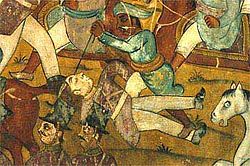
The Battle of Pollilur took place in 1780 at Pollilur near the city of Kanchipuram. It was a part of the second Anglo-Mysore war. Tippu Sultan was dispatched by Haidar Ali with 10,000 men and 18 guns to intercept Colonel Baillie who was on his way to join Sir Hector Munro. Out of 360 Europeans, about 200 were captured alive, and the sepoys, who were about 3,800 men, suffered very high casualties. Sir Hector Munro, the victor of the Battle of Buxar, who had earlier defeated three Indian rulers (the Mughal emperor Shah Alam, the Nawab of Oudh Shuja-ud-daula, and the Nawab of Bengal Mir Qasim) in a single battle, was forced to retreat to Madras, abandoning his artillery in the tank of Kanchipuram.
Fourth Mysore War
After Horatio Nelson had defeated Napoleon at the Battle of the Nile in Egypt in 1798 C.E., three armies, one from Bombay, and two British (one of which included Arthur Wellesley, the future first Duke of Wellington), marched into Mysore in 1799 and besieged the capital Srirangapatnam in the Fourth Mysore War. There were over 26,000 soldiers of the British East India Company comprising about 4,000 Europeans and the rest Indians. A column was supplied by the Nizam of Hyderabad consisting of ten battalions and over 16,000 cavalry, along with many soldiers sent by the Marathas. Thus the soldiers in the British force numbered over 50,000 soldiers whereas Tippu Sultan had only about 30,000 soldiers. The British broke through the city walls, and Tippu Sultan died defending his capital on May 4.
The Fourth Mysore war was a short affair. Keeping Tipu in false hopes, the British suddenly surprised him by unacceptable demands. When Tipu refused to accept them, the English breached the fort and in a bloody encounter, fighting against heavy odds he was killed on fourth May 1799. The battle, however, was far from one sided and it was only when the Nizam's troops advanced that the tide turned in favor of the British and their Indian allies.
In the resistance against British domination, this was the last stand before the uprising of 1857. Tippu died a Soldier's death defending his values and his land against one of the great imperial powers.
Rocket Artillery in War
A military tactic developed by Tippu Sultan and his father, Haidar Ali was the use of mass attacks with rocket brigades on infantry formations. Tippu Sultan wrote a military manual called Fathul Mujahidin in which 200 rocket men were prescribed to each Mysorean "cushoon" (brigade). Mysore had 16 to 24 cushoons of infantry. The areas of town where rockets and fireworks were manufactured were known as Taramandal Pet ("Galaxy Market").
The rocket men were trained to launch their rockets at an angle calculated from the diameter of the cylinder and the distance of the target. In addition, wheeled rocket launchers capable of launching five to ten rockets almost simultaneously were used in war. Rockets could be of various sizes, but usually consisted of a tube of soft hammered iron about 8" long and 1_ - 3" diameter, closed at one end and strapped to a shaft of bamboo about 4 ft long. The iron tube acted as a combustion chamber and contained well packed black powder propellant. A rocket carrying about one pound of powder could travel almost 1,000 yards. In contrast, rockets in Europe not being iron cased, could not take large chamber pressures and as a consequence, were not capable of reaching distances anywhere near as great.
Haidar Ali's father, the Naik or chief constable at Budikote, commanded 50 rocketmen for the Nawab of Arcot. There was a regular Rocket Corps in the Mysore Army, beginning with about 1,200 men in Haidar Ali's time. At the Battle of Pollilur (1780), during the Second Anglo-Mysore War, Colonel William Braille's ammunition stores are thought to have been detonated by a hit from one of Haidar Ali's Mysore rockets resulting in a humiliating British defeat.
In the Third Anglo-Mysore War of 1792, there is mention of two rocket units fielded by Tipu Sultan, 120 men and 131 men respectively. Lt. Col. Knox was attacked by rockets near Srirangapatna on the night of February 6, 1792, while advancing towards the Kaveri river from the north. The Rocket Corps ultimately reached a strength of about 5,000 in Tipu Sultan's army. Mysore rockets were also used for ceremonial purposes. When the Jacobin Club of Mysore sent a delegation to Tippu Sultan, 500 rockets were launched as part of the gun salute.
During the Fourth Anglo-Mysore War, rockets were again used on several occasions. One of these involved Colonel Arthur Wellesley, later famous as the First Duke of Wellington and the hero of Waterloo. Arthur Wellesley was defeated by Tipu's Diwan, Purnaiya at the Battle of Sultanpet Tope, which took place April 22, 1799, 12 days before the main battle, rockets with a range of 1,000 feet were fired into the rear of the British camp to signal the start of an attack by some 6,000 of Tipu's troops with their French mercenaries. The rocket fire caused considerable damage to the British lines, and one commentator says that Tipu's soldiers were as well trained and as well disciplined as those of the British and that his weapons were as up to date, "based on the latest French designs." "In many respects," he writes, "the Mysore troops were more innovative and technologically advanced than the company armies: firing rockets from their camel cavalry to disperse hostile cavalry for example, long before William Congreve's rocket system was adopted by the British army." As the seige took hold in mid-April, "Tipu ... as one British observer wrote, "gave us gun for gun ... and night time skirmishes were made with desperate exertion ... Soon the scenes became tremendously grand: shells and rockets of uncommon weight were incessantly poured upon us from the SW side, and fourteen pounders and grape from the North face of the fort continued their havoc in the trenches; while the blaze of our batteries, which continuously caught fire ... was the signal for the Tiger sepoys [Tipu'd elite forces dressed in tiger-striped uniforms) to advance, and pour in galling vollies of musketry."[22]
During the conclusive British attack on Seringapatam on May 2, 1799, a British shot struck a magazine of rockets within the Tipu Sultan's fort causing it to explode and send a towering cloud of black smoke, with cascades of exploding white light, rising up from the battlements. On May 3, a breach was made in the wall. On the afternoon of May 4 when the final attack on the fort was led by David Baird (a former captive of Tipu's), he was again met by "furious musket and rocket fire," but this did not help much; in about an hour's time the Fort was taken; perhaps in another hour Tipu had been shot (the precise time of his death is not known), and the war was effectively over. It was Baird who discovered Tipu's body, "with three bayonet wounds and a shot through the head."[23]Tipu held Sir David Baird and James Dalrymple prisoner for 44 months following their capture at the Battle of Pollilur. This was described at the time as "the most grievous disaster which has yet befallen the British arms in India."[24]
After the fall of Seringapatam, 600 launchers, 700 serviceable rockets and 9,000 empty rockets were found. Some of the rockets had pierced cylinders, to allow them to act like incendiaries, while some had iron points or steel blades bound to the bamboo. By attaching these blades to rockets they became very unstable towards the end of their flight causing the blades to spin around like flying scythes, cutting down all in their path.
These experiences eventually led to the Royal Woolwich Arsenal's beginning a military rocket R&D program in 1801, their first demonstration of solid-fuel rockets in 1805 and publication of A Concise Account of the Origin and Progress of the Rocket System in 1807 by William Congreve [25], son of the arsenal's commandant. Congreve rockets were soon systematically used by the British during the Napoleonic Wars and their confrontation with the United States during 1812-1814. These descendants of Mysore rockets find mention in the Star Spangled Banner.[26]
Humane Treatment for Prisoners
A clause in the proposed treaty of alliance with the French stated, " I demanded that male and female prisoners as well English and Portuguese, who shall be taken by the republican troops or by mine, shall be treated with humanity, and with regard to their persons that they shall be transported at our joint expense out of India to some place for distant from the territories of the allies." In short Tipu was an enlightened ruler, the sheet-anchor of whose state-policy was the well-being of all his subjects irrespective of caste, creed or class. He took his stand on the bedrock of humanity, regarding all his subjects as equal citizen to live in peace, harmony and concord.
Jacobin Club in Mysore
Tippu Sultan was a founder-member of the Jacobin Club. While accepting the membership, he said of France, "Behold my acknowledgement of the standard of your country, which is dear to me, and to which I am allied; it shall always be supported in my country, as it has been in the Republic, my sister!" He was named as "Citizen Tippu Sultan,"
In fiction
- In Jules Verne's The Mysterious Island, Captain Nemo is described as a nephew of Tippu Sultan. (NY: Signet Classics, 2004 ISBN 9780451529411).
- Tippu Sultan's life and adventures were the central theme of a short-running South Indian television series "The Adventures of Tipu Sultan," and of a more popular national television series "The Sword of Tipu Sultan."
- Naseem Hijazi's novels Muazam Ali (Lahore: Kaumi Kitab Khana, 1989), Aur Talwar Toot Gaye (Lahore: Kaumi Kitab Khana, 1991) describe Tippu Sultan's wars.
- Wilkie Collins novel The Moonstone contains an account of Tippu Sultan and the Fall of Seringapatam in the prologue. (Collins, Wilkie, and Steve Farmer. 1999. The moonstone. Peterborough, CA: Broadview Press. ISBN 9780585279572)
- In The Surprising Adventures of Baron Munchausen by Rudolf Erich Raspe, Munchausen vanquishes Tippoo near the end of the novel. (2007. Whitefish, MT: Kessinger Pub. ISBN 9781419184451.)
- Sharpe's Tiger by Bernard Cornwell is a novel in which the fictional soldier Richard Sharpe fights at the Battle of Seringapatam, later killing the Tipu Sultan. (NY: Harper Perennial, 1999 ISBN 9780060932305.)
- The only king who died on the battlefield is a historical novel (published in 2006) written by a United States-Pakistani resident and a young college student "Mohammed Faisal Iftikhar." The novel claims that in recent history, Tipu Sultan is the only king who died on the battlefield. (2006. Bloomington, IN: Author House. ISBN 9781425922320)
Family and Descendants
Tippu Sultan had four wives, by whom he had 16 sons and at least 8 daughters, including:
1. Shahzada Hyder Ali Sultan Sahib (1771-30 July 1815), desc
2. Shahzada Abdul Khaliq Sultan Sahib (1782-12 September 1806, desc
3. Shahzada Muhi-ud-din Sultan Sahib (1782-30 September 1811), desc
4. Shahzada Muiz-ud-din Sultan Sahib (1783-30 March 1818), desc
5. Shahzada Miraj-ud-din Sultan Sahib (1784?-?)
6. Shahzada Muin-ud-din Sultan Sahib (1784?-?)
7. Shahzada Muhammad Yasin Sultan Sahib (1784-15 March 1849), desc
8. Shahzada Muhammad Subhan Sultan Sahib (1785-27 September 1845), desc
9. Shahzada Muhammad Shukru'llah Sultan Sahib (1785-25 September 1837), desc
10. Shahzada Sarwar-ud-din Sultan Sahib (1790-20 October 1833), desc
11. Shahzada Muhammad Nizam-ud-din Sultan Sahib (1791-20 October 1791)
12. Shahzada Muhammad Jamal-ud-din Sultan Sahib (1795-13 November 1842), desc
13. Shahzada Munir-ud-din Sultan Sahib (1795-1 December 1837), desc
14. His Highness Shahzada Sir Ghulam Muhammad Sultan Sahib, KCSI (March 1795-11 August 1872), desc
15. Shahzada Ghulam Ahmad Sultan Sahib (1796-11 April 1824)
16. Shahzada Sultan Sahib (1797-1797)
Tippu Sultan's family was sent to Calcutta by the British. Noor Inayat Khan, who was a major in the British Indian army, is said to be one of Tippu Sultan's descendants who died in France under German occupation.
Legacy
Sir Walter Scott, commenting on the abdication of Napoleon Bonaparte in 1814, wrote: "Although I never supposed that he [Napoleon] possessed, allowing for some difference of education, the liberality of conduct and political views which were sometimes exhibited by old Haidar Ally, yet I did think he [Napoleon] might have shown the same resolved and dogged spirit of resolution which induced Tippoo Saib to die manfully upon the breach of his capital city with his saber clenched in his hand."[18]
Sword of Tippu Sultan
Tippu Sultan lost his sword in a war with the Nairs of Travancore who had aligned with the British in which, he was defeated. Nairs under the leader ship of Raja Keshava pillai Diwanji (Raja Keshavadas) defeated the Mysoor army near Aluva. The Maharaja, Dharma Raja, gifted the famous sword to the Nawab of Arcot, from where the sword went to London. The sword was on display at the Wallace Collection, No. 1 Manchester Square, London. At an auction in London in 2004, the industrialist-politician Vijay Mallya purchased the sword of Tippu Sultan and some other historical artifacts, and brought them back to India for public display after nearly two centuries.
Hero of Colonial Resistance
The number of books published about Tippu Suktan in post-colonial India testifies to his iconic status as a hero of resistance to domination, imperialism and as a champion of freedom. His concern for harmony between different social and religious groups, his admiration of the French Republic and his concern for public welfare, have all served to enhance his reputation and to contrast his rule in Mysore with the British Raj in India which succeeded this, which is portrayed as authoritarian, freedom-denying and unconcerned with the rights or welfare of the many. Like Siraj ud-Daulah's defeat in Bengal, Tippu's defeat in Mysore was made possible by alliances between the British and Indians. His defeat did not involve the same element of betrayal that brought Siraj down, but without the help of rival Indian princes, the British might not have defeated him. One writer describes Tippu Sultan as "a hero of the Indo-Pakistani nationalist and fold traditions" who "died fighting the British East India Company."[27]
Pioneer of Technology
Writing in the Deccan Herald, Meera Iyer recalls that Tippu's use of rockets pioneered this technology, and that his legacy in this respect reminds Indians that, "the possibilities ...are limited only by our imagination".[28] Tipu Sultan's legacy also serves as an inspiration to Indians who want India to take a lead in technological innovation and invention.
Notes
- ‚ÜĎ Binita Mehta, 2002, Widows, Pariahs and Bayad√®res: India as Spectacle. Lewisburg, PA: Bucknell University Press. ISBN 0838754554. Page 110 discusses revisionist writing about Tippu Sultan.
- ‚ÜĎ Simon Schama, 2001, A History of Britain: Volume 11: the wars of the British, 1603-1776. New York, NY: Hyperion/Miramax. ISBN 9780786867523. 517.
- ‚ÜĎ Ramusack 2004, 32.
- ‚ÜĎ Ramusack 2004, 31.
- ‚ÜĎ W. Kirkpatrick, 1811, Select Letters of Tippoo Sultan. Publisher: London, UK: Printed for Black, Parry and Kingsbury.
- ‚ÜĎ M. Wilks, 1864, Report on the Interior Administration, Resources and Expenditure of the Government of Mysore under the System prescribed by the Order of the Governor-General in Council dated September 4, 1799. Bangalore, IN: Mysore Government Press and Historical Sketches of the South of India in an Attempt to Trace the History of Mysore with Hammick, Murray (1930 2 Vols) republished 1989. New Delhi, IN: Asian Educational Services.
- ‚ÜĎ C. C. Davies, 1953, "Review of The History of Tipu Sultan by Mohibbul Hasan." The English Historical Review. 68(266):144-145.
- ‚ÜĎ A. Chetty, Subbaraya, ‚ÄúTipu‚Äôs endowments to Hindus and Hindu institutions‚ÄĚ in Habib. 2002. 111.
- ‚ÜĎ Habib 2001, 5.
- ‚ÜĎ Hasan 1971, 368.
- ‚ÜĎ Brittlebank 1997, 10-12. On page 2 she writes ‚Äúit is perhaps ironic that the aggressive Hinduism of some members of the Indian Community in the 1990s should draw upon an image of Tipu which, as we shall see, was initially constructed by the Subcontinent‚Äôs colonizers.‚ÄĚ
- ‚ÜĎ Hasan 1971, 362-363.
- ‚ÜĎ Hasan 1971, 357-358.
- ‚ÜĎ A. S. Chetty, 2002, ‚ÄúTipu‚Äôs endowments to Hindus‚ÄĚ in Habib. 111-115.
- ‚ÜĎ 1916. Annual Report of the Mysore Archaeological Department. 10-11, 73-76.
- ‚ÜĎ Hasan 1971, 359.
- ‚ÜĎ B. A. Saletare, ‚ÄúTipu Sultan as Defender of the Hindu Dharma‚ÄĚ in Habib. 2002. 116-118.
- ‚ÜĎ 18.0 18.1 18.2 18.3 2000. Tipu Sultan, Ruler of Mysore. Tiger and Thistle. Retrieved February 5, 2009.
- ‚ÜĎ Veronica Murphy, 1976, Tippoo's Tiger. London, UK: Victoria and Albert Museum.
- ‚ÜĎ Tipu. Global Security. Retrieved February 5, 2009.
- ‚ÜĎ Ramusack 2004, 31.
- ‚ÜĎ Will Dalrymple, 2004, White Mughals: Love and Betrayal in Eighteenth Century India. New York, NY: Penguin. ISBN 0670031844. 151-152.
- ‚ÜĎ Dalrymple 2004, 152.
- ‚ÜĎ Dalrymple 2004, 151.
- ‚ÜĎ Stephen Leslie, 1887, "Congreve, Sir William," Dictionary of National Biography. New York, NY: Macmillan & Co. Vol.XII, 9.
- ‚ÜĎ Alen W. McDonnell, The Rockets Red Glare. ctie.monash.edu.au. Retrieved February 5, 2009.
- ‚ÜĎ Amyn B. Sajoo, 2004, Civil Society in the Muslim World: Contemporary Perspectives. London, UK: Institute for Ismaili Studies. ISBN 9781850435907. 290.
- ‚ÜĎ Meera Iyer, 2008, A forgotten slice of history. The Deccan Herald. Retrieved February 5, 2009.
ReferencesISBN links support NWE through referral fees
- Agha, Shamsu. Tipu Sultan," "Mirza Ghalib in London";, "Flight Delayed", (three plays) London, UK: Waltham Forest Race Relations Unit.
- Bowring, Lewin. 1997. Haidar Ali and Tipu Sultan and the Struggle with the Musalman Powers of the South. New Delhi, IN: Asian Educational Services. ISBN 812061299X.
- Brittlebank, Kate. 1997. Tipu Sultan's Search for Legitimacy: Islam and Kingship in a Hindu Domain. Delhi, IN; New York, NY: Oxford University Press. ISBN 9780195639773.
- Habib, Irfan. 2001. State and Diplomacy Under Tipu Sultan: Documents and Essays. New Delhi, IN: Tulika. ISBN 9788185229508.
- Habid, Irfan (ed). 2002. Confronting Colonialism: Resistance and Modernization Under Haider Ali and Tipu Sultan (Anthem South Asian Studies). London, UK: Anthem Press. ISBN 1843310244.
- Hasan, Mohibbul. 1971. History of Tipu Sultan. Calcutta, IN: Aakar Books. ISBN 8187879572.
- Hasan, Mohibbul. 2005. Tipu Sultan's Mission to Constantinople. Delhi, IN: Aakar Books. ISBN 8187879564.
- Home, Robert. 2000. Select Views in Mysore: The Country of Tipu Sultan from Drawings Taken on the Spot by Mr. Home. New Delhi, IN: Asian Educational Services. ISBN 8120615123.
- Moienuddin, Mohammad. 2000. Sunset at Srirangapatam: After the death of Tipu Sultan. Hyderabad, IN: Orient Longman. ISBN 8125019197.
- Ramusack, Barbara N. 2004. The Indian princes and their states. The new Cambridge history of India, III, 6. Cambridge, UK: Cambridge University Press. ISBN 9780521267274.
- Strandberg, Samuel. 1995. Tipu Sultan: The Tiger of Mysore: or, to fight against the odds. Stockholm, SE: AB Samuel Travel. ISBN 9163073331.
- Taylor, George. 1989. Coins of Tipu Sultan. New Delhi, IN: Asian Educational Service. ISBN 8120605039.
- Wigington, Robin. 1992. Firearms of Tipu Sultan, 1783-99. Hatfield, UK: J. Taylor Book Ventures. ISBN 1871224136.
External links
All links retrieved April 30, 2023.
- Biography.
- The Sword of Tippu Sultan.
- The Tiger of Mysore ‚Äď Dramatized account of the British campaign against Tipu Sultan by G. A. Henty, from Project Gutenberg.
Credits
New World Encyclopedia writers and editors rewrote and completed the Wikipedia article in accordance with New World Encyclopedia standards. This article abides by terms of the Creative Commons CC-by-sa 3.0 License (CC-by-sa), which may be used and disseminated with proper attribution. Credit is due under the terms of this license that can reference both the New World Encyclopedia contributors and the selfless volunteer contributors of the Wikimedia Foundation. To cite this article click here for a list of acceptable citing formats.The history of earlier contributions by wikipedians is accessible to researchers here:
The history of this article since it was imported to New World Encyclopedia:
Note: Some restrictions may apply to use of individual images which are separately licensed.
